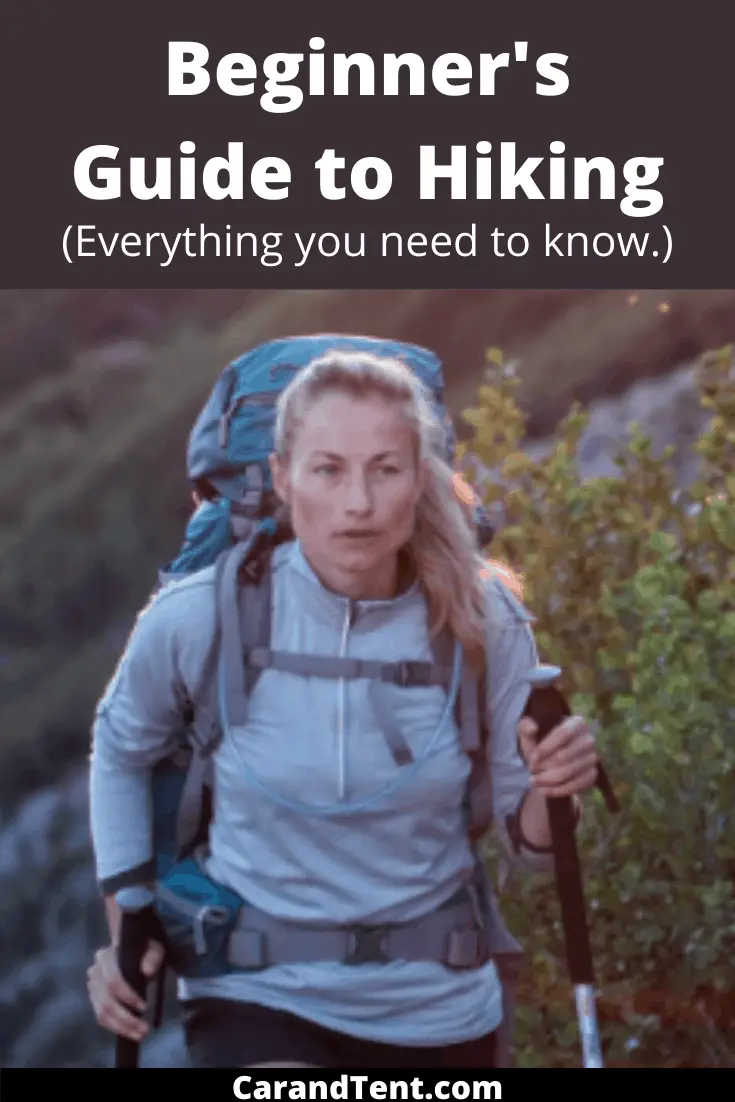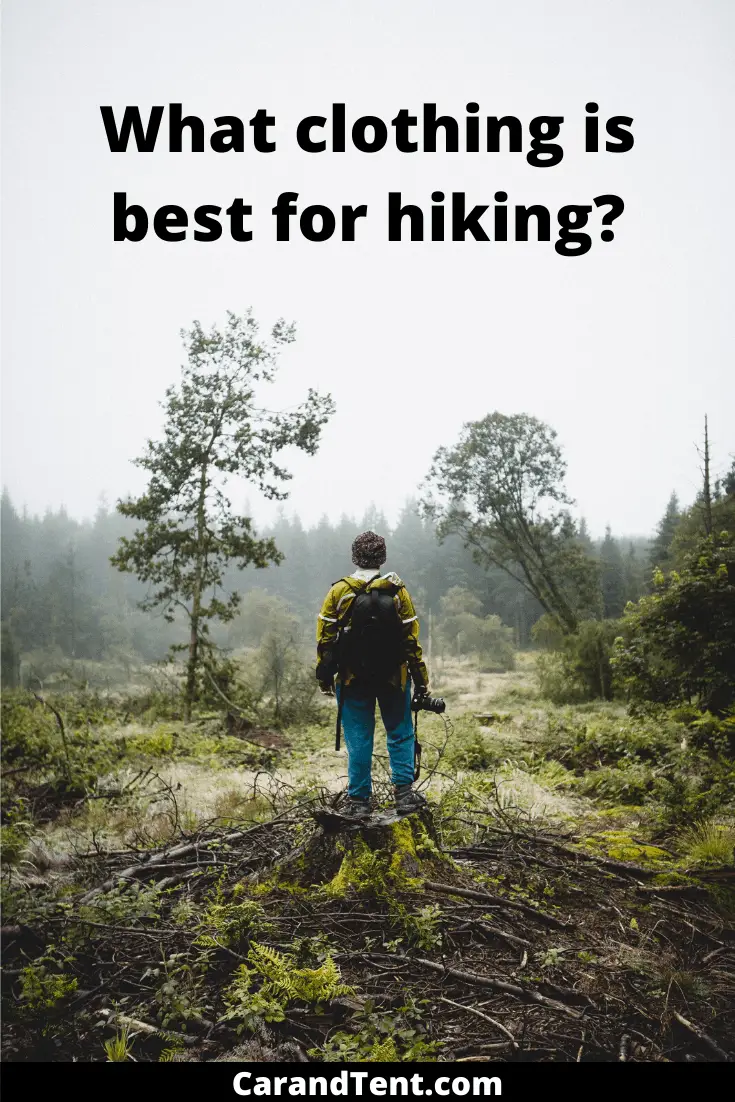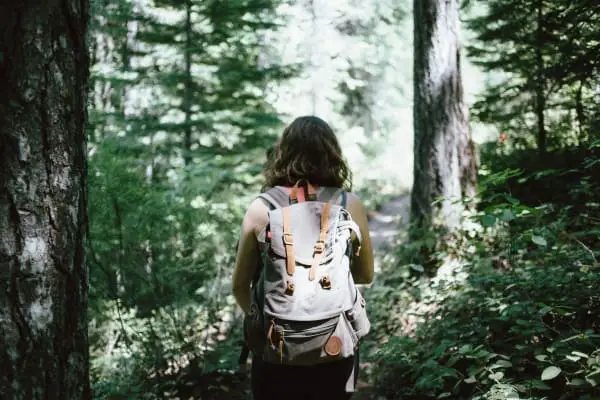
Getting started in hiking can be confusing. Some people claim hiking is just walking. Others treat it like it’s a perilous journey that only a crazy person would undertake.
Like most things, it can be either one of these and the truth is usually somewhere in between. In this beginner’s guide to hiking, I’ll shine the light on things and break everything down for you so that you too can become a hiker.
Table of Contents
Why Hike in The First Place
There are so many benefits to hiking that it is hard to understand why everyone isn’t doing it on a weekly or even daily basis. Hiking is good for your physical, mental, and emotional health. It’s also a great hobby.
This is because it’s easy to get started, it can be done alone or with a group, and it usually doesn’t cost very much to get into. Also, most people have access to hiking trails so it’s a very accessible hobby as well.
Physical Health Benefits of Hiking
Hiking is a load bearing exercise. As such, it strengthens your muscles and your bones. It also provides protection against the development of osteoporosis.
Additionally, hiking improves your cardiovascular system. It strengthens your heart and your lungs and reduces your chances of developing diabetes, hypertension, and heart disease.
On top of all of this, hiking is a great way to burn calories. Depending on your weight, you’ll burn anywhere from 300 to 600 calories per hour while hiking.
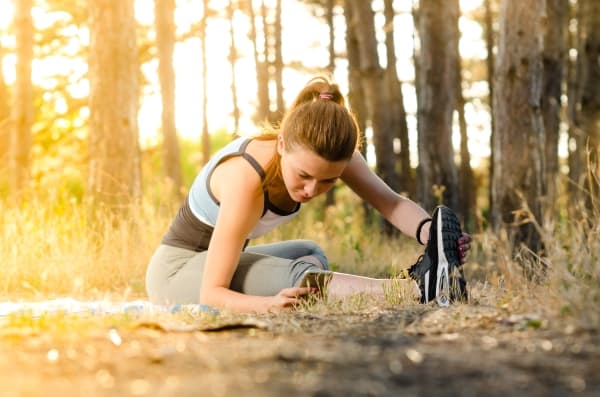
Mental and Emotional Health Benefits of Hiking
Your mental and emotional health will likely be improved while hiking as well. According to the National Institute of Health, physical exercise has been proven to improve memory skills in people of all ages.
Exercise can also improve your mood as well. This is because physical activity releases endorphins which can reduce depression and anxiety.
On top of this, being in nature also provides additional emotional health benefits as well. For more details on this, check out the section on stress on my post titled, “Why is Camping Good For You“.
The Hobby Factor
Some people don’t even consider the health benefits of hiking when they put on their hiking boots. This is because they do it for the sheer fun of it.
Hiking makes a great hobby because it’s one that you can do by yourself or with a group. You don’t even have to learn many new skills and you can continue to do it as you age. Also, it gets you outside, exposes you to nature, and can lead to many crossover hobbies like camping and landscape photography.
On top of all of this, it doesn’t cost much money to get started in hiking. In fact, you can probably get started with the items you already have lying around your house.
Where to Go Hiking
Do a quick Google Maps search for hiking trails and you’ll be surprised at just how many hiking trails are within a short driving distance of where you live. The hardest part will be in deciding which ones to visit first.
My recommendation is for beginner hikers to stick to shorter trails located close to or within heavily populated areas. This dramatically reduces your chances of getting lost and puts you closer to help should you need it.
If you’re in good shape, start out with a three to six-mile hike. If your level of fitness could use a bit of improvement, try a trail that’s only a mile or two. If you still feel fresh when you’re done, hop on another short trail or do the loop again but in reverse.
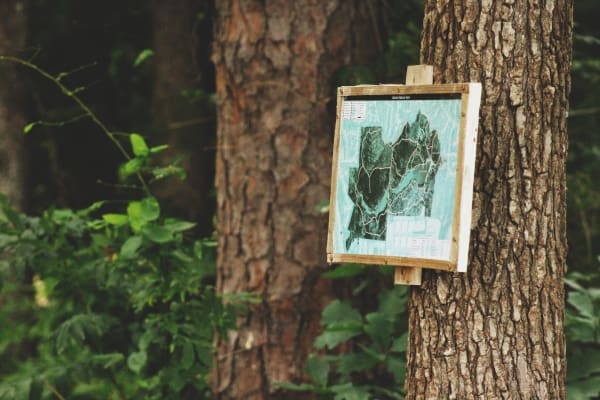
What to Wear on a Hike
You can find an endless amount of hiking clothing and hiking boots online or at your local outdoor store. Ask them what you’ll need and you’ll probably end up leaving the store with a shopping cart full of expensive hiking clothing and hiking footwear.
Fortunately, you don’t really need most of these things when you’re first starting out. You just need some basic hiking clothing and some basic footwear to keep you safe and comfortable.
Hiking Clothing
When you’re just getting started, it doesn’t make sense to buy a bunch of fancy hiking clothing just to go on short day hikes. Instead, wear layers and dress for the weather you’ll be hiking in.
Here is what I’d recommend you start with:
- A hat.
- Sunglasses.
- A moisture-wicking shirt.
- Comfortable pants.
- A plastic poncho.
- A zip-down jacket or coat.
Ideally, you’ll have a wide-brimmed hat to minimize your exposure to the sun. Alternatively, you could wear a baseball cap and sunscreen. If it’s cold out, you could wear a beanie instead.
You’ll want sunglasses regardless of the weather. Even cloudy days can quickly turn into sunny days so it doesn’t hurt to bring a pair along with you.
If you have an Under Armour shirt or something similar, you’ll want to wear it. Otherwise, a cotton t-shirt will work just fine. Just pack an extra one since you might have issues with sweat not drying out quickly enough.
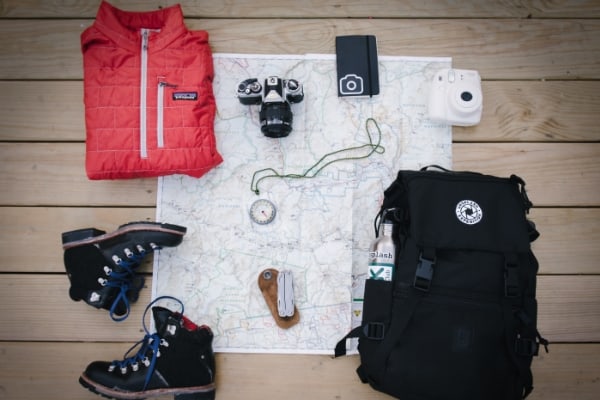
Hiking pants are great but for short hikes, you can get away with anything from a pair of jeans, leggings, sweatpants, and even gym shorts. Personally, I prefer long pants as it helps to protect against bugs, insects, and poison ivy.
You can get a plastic poncho at the dollar store to bring along with you. These ponchos are a pain to reuse but they’re great for emergencies. Put one in your pocket and you’ll have some protection against a potential downpour.
If it’s cold enough for a coat or a jacket, you’ll want to bring one that zips open easily. You’ll get hotter than you might think while hiking in cold weather so it’s nice to be able to open up your jackets without having to take them off right away.
Once you’ve gained enough experience to go on longer hikes, you can upgrade your hiking clothing.
Here are some additional items you might want to consider:
- Wet weather gear.
- Hiking pants.
- Hiking gaiters.
Wet Weather Gear
Wet weather gear expands your hiking options as it makes it easy to go hiking even if the weather looks questionable. In fact, I’ve purposely gone on quite a few hikes in the rain.
Wet weather gear can come in the form of a good poncho or a jacket and a pair of wet weather pants. A poncho is more convenient to carry in a daypack and it provides more airflow than the jacket and pants combination.
However, a jacket and a pair of pants will give you a lot more protection against the weather. Also, short ponchos seem to funnel all of the water to your thighs and longer ponchos seem to funnel all of the water into your shoes. Both of these scenarios are pretty irritating.
You can learn more about hiking in the rain in my post titled, “15 Tips for Hiking in the Rain“.
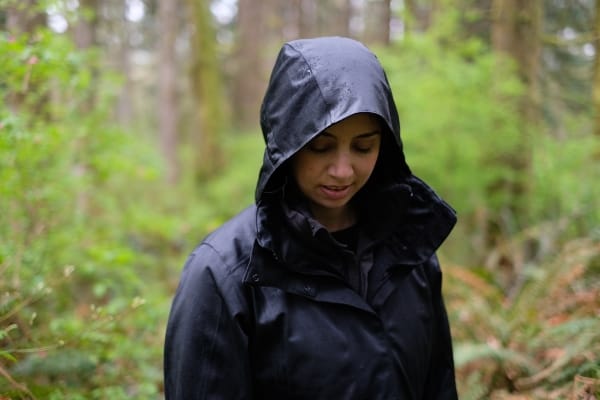
Hiking Pants
After hiking in jeans for years, I finally bought a pair of hiking pants and immediately wished I would have done it sooner. Hiking pants are incredibly comfortable for two reasons.
Firstly, they are a lot more flexible. This makes taking long steps up and over rocks and trees a lot easier.
Secondly, hiking pants are made of lightweight and breathable materials that wick water away from your body. This makes them kind of dreamy on a hot summer day.
Hiking Gaiters
Hiking gaiters are great for winter hiking as they help to keep snow and ice out of your boots. They’re also good for summer hikers who want some protection for their legs when they wear shirts instead of pants.
Wearing them may also provide some protection against snake bites as well. As I said earlier, I prefer to wear long pants all year long so I generally stick to wearing gaiters when winter hiking or snowshoeing.
Hiking Footwear
I love hiking boots and have been known to wear them pretty much everywhere. However, you don’t really need hiking boots to go hiking.
When you’re just starting out on short and easy trails, a pair of running shoes or cross-trainers will do just fine. You can upgrade to hiking boots and other types of fancy hiking footwear when you begin to hike more often and on more difficult trails.
You can read all about hiking footwear on my post titled, “Do You Need Hiking Boots – The Rundown on Hiking Footwear“.
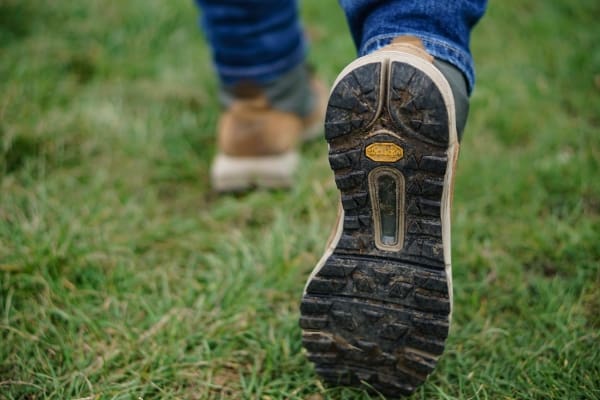
Beginner Hiking Gear
The incredible amount of hiking gear that a person can buy is astonishing. You can buy almost anything you could possibly think of.
But do you need to buy all of this stuff?
When you’re just starting out, you probably won’t be going on many long and strenuous hikes, so why carry a bunch of unnecessary gear?
Here is what I recommend you start with:
- A day pack.
- A water bottle.
- A first-aid kit.
- An emergency blanket.
- A flashlight.
- A knife.
The Hiking Day Pack
A day pack is important because you can carry the other items on the list above as well as your food and some extra clothing. Your day pack doesn’t have to be very big or expensive and if you’re into photography, you can buy a nice camera bag that doubles as a day pack.
You can read about the camera bag I use at https://www.carandtent.com/lowepro-photo-hatchback-22l-camera-backpack-review/.
Stuff to Go Inside Your Hiking Day Pack
Here is a quick run-down on the other items I recommend you bring with you on your hike.
Water Bottle
Your water bottle can be a single-use one that you buy from the store but personally, I prefer to have some dedicated water bottles that I can refill. It’s better for the environment and it’s a lot less expensive in the long run.
Alternatively, you could buy a water bladder to go underneath of your day pack. These bladders have come down a lot in price over the last fifteen years and you can get them for less than $20.00. They’re great for hiking, backpacking, kayaking, snowshoeing, and even running.
First Aid
You can get a ready-made first aid kit or you can make your own using a small plastic case as the base. If you make your own, I’d recommend you at least put the following items into it:
- Bandaids
- Gauze
- An Ace Bandage
- Pain Reliever
- Anti-itch Cream
- Antibiotic Cream
Emergency Blanket
The emergency blanket is essentially a piece of mylar. You can get them for less than a dollar or you can buy bulk packages of them for around 50 cents each.
These blankets aren’t very durable and I wouldn’t want to be caught in freezing temperatures with just a mylar blanket, but they are still worth taking with you. This is because they can reflect body heat back on you and since they’re waterproof, you can put them to other uses as well.
Also, these blankets weigh very little and do not take up much space. When I go kayaking, I’ll usually toss an emergency blanket into my pocket. This way even if end up on the riverbank with nothing but the clothes on my back, I’ll still have a useable blanket with me. When hiking, I’ll just put the blanket in my day pack instead.
An alternative to the emergency blanket that you may want to consider is an emergency sleeping bag. These are basically emergency blankets that provide a bit more protection from heat loss. The only downside to them over the emergency blanket is that you’ll have to cut one side of them to turn them into a tarp or a ground cover.
Flashlight
The flashlight doesn’t have to be anything fancy. Just get an LED one so that you don’t have to worry about the bulbs. It’ll also last a lot longer so you won’t have to worry about changing the batteries quite as often.
Some people prefer to pack a headlamp instead of a flashlight. This can be a great idea since it leaves your hands free. It also gives you the option to have two light sources without having to pack two flashlights since you can always use your cell phone as a flashlight in concert with your headlamp.
Knives
A small knife will make everything in the woods a little easier. Choose a knife with a small 2.5-inch blade so that it’s easy to pack and to carry. You won’t be able to fight off people and animals with a knife this small, but this isn’t really what it’s for anyway.
During an everyday hike, you can use your knife to accomplish more mundane tasks like opening up food packages. In an emergency situation, you can use it to open up items from your first aid kit and to cut up kindling to use in an emergency fire. The uses for a good knife can become almost infinite in an emergency situation.
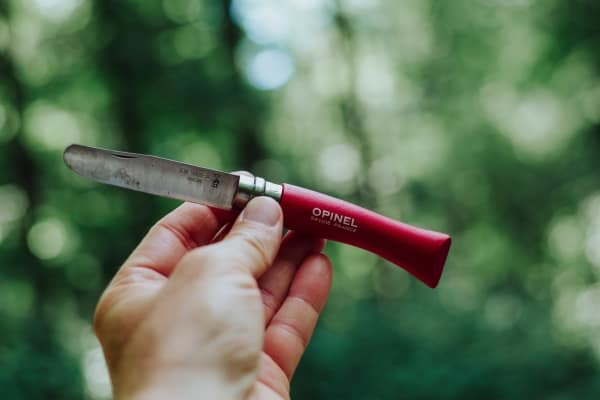
Hiking Navigation
When you’re just getting started with hiking, it’s a good idea to choose trails that aren’t very complicated or difficult to navigate. More urban hiking trails will have easy to follow trail maps and the trails will usually be marked quite well for you to follow.
Before going on longer hikes, you may want to learn the basics of navigation and map reading. Think about learning the art of orienteering and learn how to properly read a topographic map and you’ll never get lost.
To make things even easier, you may want to consider getting a hiking GPS. A modern hiking GPS should be able to get you within a few feet of your destination and you’ll often be able to load trails onto the GPS to make navigating even easier.
Just remember that a hiking GPS is no substitute for learning proper navigation as GPS systems can fail. A hiking GPS should be brought in addition to a topographic map and not in place of one.
Hiking Food and Water
Hiking burns a lot of calories. As you know from my post titled, “Hiking vs Running“, a one-hour hike can easily burn off 432 calories for a 150-pound person and even more for heavier people.
As such, you’ll want to pack something to eat on your hike. Even if you only plan on going for a one or two-hour hike, it’s still a good idea to pack some food. You can eat this food if you decide to hike a little longer when you get there or you may end up needing it should you get stranded, lost, or injured.
Some good and easy hiking foods you can pack with you are:
- Protein Bars
- Trail Mix
- Granola Bars
- Peanut Butter Sandwiches
- Fruit Bars
- Dehydrated Fruit
Dry foods are often best because they are easy to store, keep well, and don’t weigh much. They’re also packed full of calories which you’ll need when you’re out hiking.
I’d also suggest you bring about 16 ounces of water with you per hour of hiking. This will satisfy the recommended daily amount of 8 ounces of water an hour and will provide the extra water that you’ll need because of your hike.
Hiking Safety
Other than getting lost or injured in the woods, there are seven things you need to be mindful of. These seven things are nature, the weather, plants, bugs, insects, animals, and people.
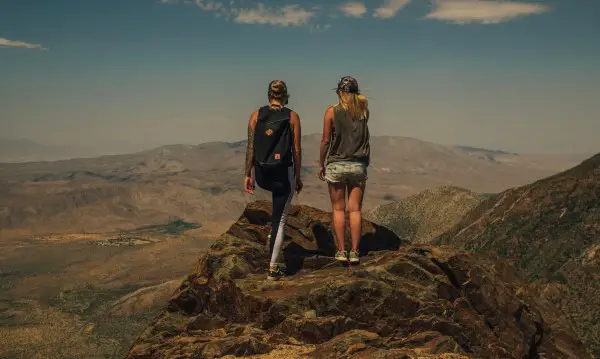
Nature
When you’re out in the natural landscape, you’ll have to be more mindful of nature. Some trails are very well monitored while others are not.
For example, a hiking trail may pass under many dead trees and you’ll have to keep an eye and ear out for them on windy days or risk being crushed by them. Falling rocks and mudslides can also be an issue as some trails aren’t monitored for slope deficiencies that so often lead to landslides.
Plant Life
It isn’t just trees that might try to harm you either. I’ve been on a few trails that were covered in poison ivy. In fact, this is one of the main reasons that I hike mostly in long pants.
If you don’t know how to identify the poisonous plants in your area, it might be wise to do some research before you head out. Find out what poison ivy, poison oak, poison sumac, and any other dangerous plants look like so that you’ll know to avoid them on your hikes.
The Weather
The weather can be harmful in two ways. For starters, it can harm you directly through lightning strikes, hail, chilling winds, and even sunburn. Secondly, it can hurt you by affecting the natural landscape.
For instance, a rainstorm in an area that has recently experienced a drought can cause mudslides and flooding. A strong windstorm can knock down trees and even create snowdrifts.
Always check the weather right before heading out for a hike so that you can decide whether or not to go on your hike and what precautions you need to take before heading out. Also, always assume that the weather will take a turn for the worst, and remember that forecasts are not always accurate. If the weather begins to feel unsafe while you’re out on your hike, there’s no shame in turning back and going home.
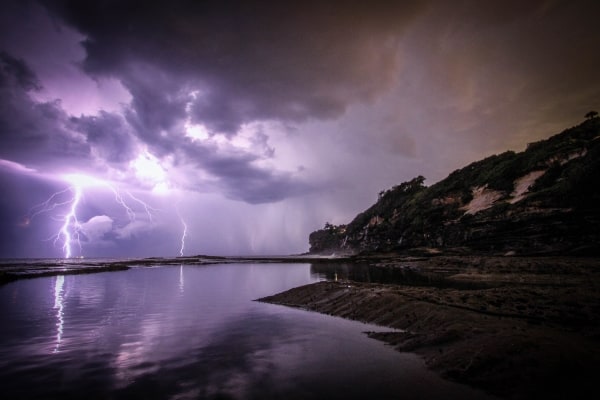
Bugs and Insects
Ticks, poisonous spiders, fire ants, scorpions, mosquitos, and even flies can all come out to attack you while you hike. If you want to avoid these creatures, your best bet is to choose a well-groomed and well-traveled hiking trail. A well-groomed hiking trail will have fewer ticks on it and a well-traveled trail will have fewer spider webs for you to deal with.
Either way, you’ll want to bring some protection against these bugs and insects. A bug spray with DEET will work well to camouflage your skin while clothing sprayed in advance with Permethrin will help to kill bugs on contact.
My personal preference is to wear long pants and to spray myself with DEET. This is not as harmful to the environment and many studies have shown that DEET is safe for humans.
Animals
Most animals will not bother with hikers and you may be hard-pressed to even spot any animals other than birds and squirrels while out on a hike. However, this isn’t always true and some people have been attacked by bears, mountain lions, and even angry deer.
Always bring bear spray and learn how to use it beforehand. Bear spray is a very effective deterrent for bears as well as other predatory animals.
For more information on dealing with bears while hiking, see my post on camping with bears.
People
People are usually more dangerous than animals. While it might seem counterintuitive, the best way to stay safe from other people while hiking is to hike on trails with a lot of people.
Luckily there are more good people in the world than there are people that wish to do harm to others. Hike a trail with a lot of people on it and you’re much less likely to be bothered.
Alternatively, you can bring your own people with you. In fact, I’d suggest that you go group hiking for at least your first few hikes. This will give you additional protection against anything that might go wrong and will increase the chances that your first hike will be a successful one.
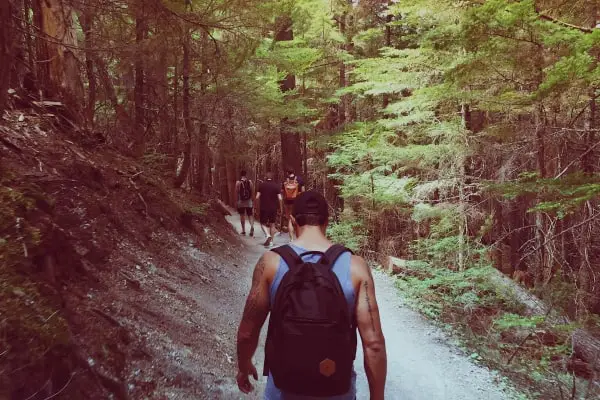
Getting Fit for Hiking
If you don’t feel like you’re quite fit enough to go hiking, you can always become fit enough for hiking by working out off the trail. Strengthen your leg muscles by walking around your neighborhood, walking steps, using the treadmill at an incline, or by using the Stairmaster at the gym. You may also find that doing high-volume strength training exercises can be beneficial to you as well.
To strengthen your cardiovascular system before you head out on a hike, consider cycling, swimming, jogging, walking or playing sports. Any activity that increases your heart rate for extended periods of time will help prepare you for your next hike.
Solo Hiking
I’ve written an entire post on how to hike alone and I highly recommend that you try it at least once in your life. Hiking alone is a different experience than group hiking and it can provide many benefits that group hiking cannot provide.
This being said, I would recommend that you do your first solo hike on a busy and easy hiking trail. Doing so will dramatically decrease the chances that you’ll get lost or injured. It will also increase the chances that someone will be around to help you if you do.
Group Hiking
Group hiking is easy for people who already have friends or family members that like to hike. However, what about the people that don’t?
If you don’t have anyone that you can readily go hiking with, try convincing your health-conscious friends to do so first. These people will be easier to convince since hiking really is a great workout.
If you can’t convince your friends to go hiking with you, consider making new friends that will. There are many hiking clubs and meetup groups online that you can join to meet others who would love to go hiking with you.
Final Thoughts
Hiking is a great activity for beginners as it is both cheap and easy to get started. Start off slow and easy and increase the difficulty level of your hikes as you begin to learn new skills. Be safe and stay smart and you’ll have a new hobby that you can do for the rest of your life.


